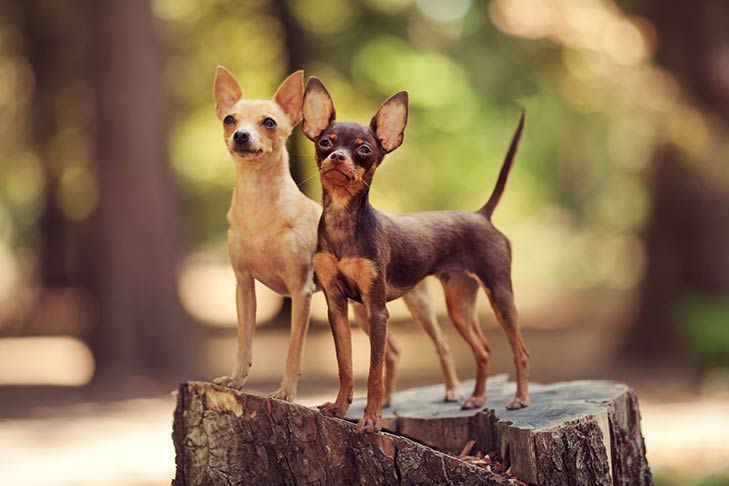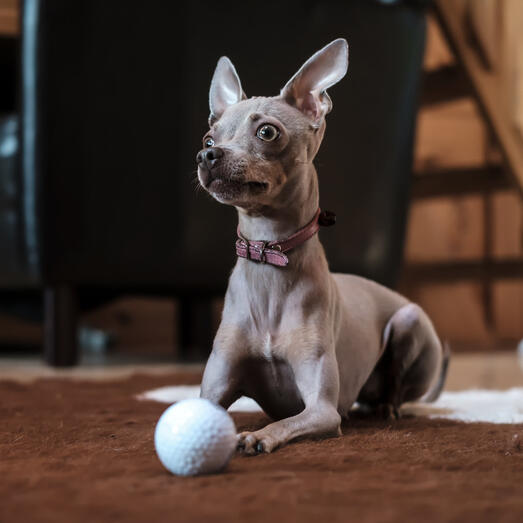The Russian Toy Terrier is a small, active breed with a history dating back to the Russian aristocracy. Known for its spirited and loyal temperament, this dog requires consistent training and a diet tailored to its size.
Tracing its origins to the 18th century, the Russian Toy Terrier emerged as a prestigious companion for Russian nobility. Over time, the breed adapted to a broader societal role, becoming a beloved pet among various social classes. Despite their diminutive size, these dogs boast an exuberant personality, displaying a mix of playfulness and devotion.
Their intelligence and alertness make them quick learners, although their independent streak calls for a patient and positive approach to training. As for their dietary needs, owners must focus on providing balanced nutrition appropriate for a small-breed dog, ensuring that the Russian Toy Terrier maintains its vigor and health. Introducing potential owners to this vivacious breed, it’s clear that the Russian Toy Terrier, with proper care, can be a charming and engaging addition to any home.
:max_bytes(150000):strip_icc()/russian-toy-profile-treatment-irinaabs-7460c1d033e14ea2b72120b25d082504.png)
Credit: www.dailypaws.com
Introduction To The Russian Toy Terrier
The Russian Toy Terrier, a breed renowned for its elegant appearance and spirited personality, has roots dating back to the Russian aristocracy of the 18th century. Its ancestry is linked to the English Toy Terrier, which arrived in Russia during this period. The upheavals of the Russian Revolution caused the breed to nearly vanish, but dedicated breeders in the mid-20th century revived the Russian Toy Terrier, emphasizing both its unique traits and its status as a distinct breed.
The Russian Toy Terrier, often referred to simply as the Russian Toy, has gained recognition from canine organizations across the world. The Fédération Cynologique Internationale (FCI) recognizes the breed under the name Russkiy Toy, making it eligible for show and companion status globally. Despite its growing popularity, the breed retains a certain exclusivity due to its relative rarity outside its native Russia.

Credit: www.akc.org
History And Development Of The Russian Toy Terrier
The Russian Toy Terrier has its roots in the aristocratic circles of Russia, emerging as a distinct breed in the late 19th century. Initially bred for companionship among the Russian nobility, these diminutive terriers were shaped by their role as attentive and affectionate lapdogs. Over time, they evolved from their ancestors, notably the English Toy Terrier, adapting to the cultural and climatic conditions of Russia.
As breed standards began to crystallize, the Russian Toy Terrier took on a more formal identity. By the mid-20th century, efforts to establish a recognized breed standard were underway, amidst challenges such as the October Revolution and World War II that nearly led to its extinction. Post-war survival and breed refinement have resulted in the captivatingly elegant and sprightly canine we know today.
The global expansion of the breed’s popularity began in earnest following the dissolution of the Soviet Union, as the newly christened Russian Toy made its way across Europe and, subsequently, to other continents. The breed has been welcomed by a growing audience, charmed by its vivacious temperament and pint-sized stature, making the Russian Toy Terrier a beloved pet worldwide.
Temperament And Behavioral Traits Of The Russian Toy Terrier
The Russian Toy Terrier is known for its lively and spirited disposition, often showing a boundless amount of energy and a keen alertness that makes them excellent watchdogs. With a propensity for forming strong bonds with their owners, they exhibit a level of loyalty and affection that belies their diminutive size. This breed thrives on consistent interaction and companionship, often mirroring the mood and emotion of their human counterparts.
Interactions with children and other animals can vary with individual dogs. Typically, Russian Toy Terriers do well if they have been socialized properly from a young age. Respectful play with children is possible, though their small size makes supervision a necessity to prevent accidental injury. When introduced correctly, they can coexist peacefully with other pets, though some may display territorial behaviors.
Owners may encounter behavioral challenges such as stubbornness or excessive barking. Mitigating these issues is often a matter of patience, positive reinforcement, and structured training routines. Consistency in training and socialization is crucial in cultivating a well-mannered dog. Early exposure to various environments and situations is beneficial in shaping their adaptability and temperament.
Training The Russian Toy Terrier
Training the Russian Toy Terrier demands patience, consistency, and understanding of this breed’s idiosyncrasies. A crucial step for owners is promoting socialization early on, exposing the dog to various people, animals, and environments. This breeds familiarity and prevents future behavioral issues. Obedience training should commence with basic commands, employing positive reinforcement techniques such as treats or praise to encourage compliance.
Small breeds can sometimes develop the Small Dog Syndrome, a byproduct of not establishing clear boundaries and allowing certain behaviors to go unchecked due to the dog’s miniature size. To counteract this, trainers should enforce gentle yet firm leadership, ensuring the dog understands its role in the family hierarchy. For bark training, consistency is key; address excessive barking by teaching the ‘Quiet’ command or using distraction techniques.
- Introduce the Russian Toy Terrier to new situations gradually.
- Use positive reinforcements to build a bond during training sessions.
- Address Small Dog Syndrome with determined, consistent leadership.
- Employ quiet commands and distractions to manage barking.
Feeding And Nutrition For The Russian Toy Terrier
The Russian Toy Terrier requires a balanced diet tailored to their unique physiological needs. As a small breed, they demand a high-quality, nutrient-rich diet that supports their energy levels without leading to weight gain. The recommended feeding regime splits their daily food intake into two meals, helping to maintain stable blood sugar levels and minimize the risk of overfeeding.
Understanding the correct portion sizes is critical for the health and well-being of a Russian Toy Terrier. It’s essential to consult with a vet to determine the individual caloric needs based on the dog’s age, weight, and activity level.
| Food Type | Benefits | Considerations |
|---|---|---|
| Dry Food | Convenient, helps with dental health | Must be high-quality, balanced |
| Wet Food | Hydrating, appetizing | Can contribute to weight gain if not measured |
| Homemade | Potential for fresh, tailored meals | Requires thorough understanding of dog nutrition |
| Store-Bought | Convenient, formulated to meet nutritional standards | Quality varies, labels should be checked |
Selecting the right food involves choosing between dry and wet options, or a combination of both, depending on the dog’s preference and health requirements. Homemade diets can offer fresh, personalized meals but necessitate a deep knowledge of canine nutritional needs to avoid deficiencies. Conversely, store-bought foods provide convenience and are formulated to meet dietary standards, yet the quality varies, so it’s crucial to scrutinize labels.

Credit: www.purina.co.uk
Frequently Asked Questions Of Russian Toy Terrier History, Temperament And Behavior, Training, Feeding
What Is The Origin Of Russian Toy Terriers?
Russian Toy Terriers, also known as Russkiy Toys, originated in Russia during the 20th century. They were bred from English Toy Terriers and were popular amongst Russian nobility.
How Does The Russian Toy Terrier Behave?
Russian Toy Terriers are known for their lively and affectionate nature. They form strong bonds with their owners and can be quite playful and active despite their small size.
What Are The Training Needs Of Russian Toy Terriers?
Due to their intelligence, Russian Toy Terriers respond well to training. Consistent, positive reinforcement methods work best, as they can be sensitive to harsh treatment.
What Is The Ideal Diet For A Russian Toy Terrier?
A balanced diet suitable for small breeds is ideal for Russian Toy Terriers. It should be rich in nutrients to support their high energy levels and overall health.
Conclusion
Discovering the captivating world of the Russian Toy Terrier is indeed enlightening. This charming breed’s rich heritage pairs with an amiable temperament that wins hearts. Whether you’re training a pup or planning their diet, understanding their unique requirements is key.
Embrace the journey with your Russian Toy Terrier and cherish every moment of companionship and adventure.
